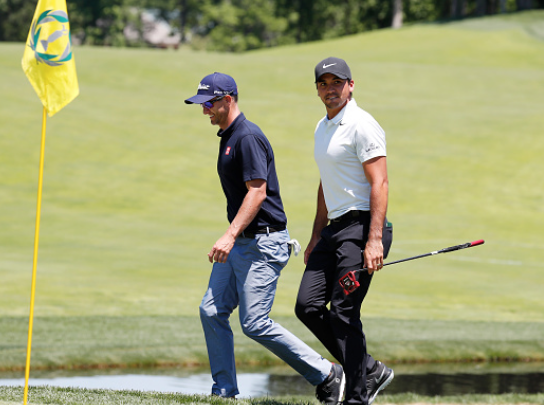There’s a chance the Erin Hills layout could be played at 7800 yards this week.
Actually, if not for infrastructure, the USGA could theoretically stretch out what they’re calling a “heartland” course beyond 8000 yards.
Barring the right winds, it will likely play at 7741 yards – still comfortably the longest course in major championship history and clearly a beast.
Adam Scott has kept the heat up on the USGA for the past couple of weeks warning it not to push too hard on the course set-up so the Wisconsin giant, hosting its first major, remains playable.
“The USGA is going to need to be very attentive to the wind and will need to be cautious and conservative on forecasts as we definitely do not want to be caught out,” Scott said.
“The rough is just so tall and so thick you could lose a caddie,” the Queenslander joked.
“And caddies will not be the only things lost in the rough this week,” he said more seriously.

For the first time in 25 years – and just the ninth time since World War II – the US Open will be played as a par 72.
The last time came at Pebble Beach in 1992, when the 502-yard second hole was still played as a par five. Since then, the US Open has generally been played at par 70, with Pebble Beach adjusted to par 71 the two most recent times it has hosted the event.
Erin Hills actually played as a par 73 in 2009 after some alterations to the course, but has since reverted.
By way of contrast, Royal Sydney, host course of last year’s Emirates Australian Open, played approximately 700m shorter than this week’s beast, carved by ancient glacier as much as architects and their heavy machinery.
USGA boss Mike Davis says the fairway set-up is “bouncy”, so it won’t seem as long to play as some of the numbers suggest.
But rest assured, this spectacular rural course is still VERY long – and that’s without the long walks from green to tee.
There are plenty of elevated tees and greens, the latter featuring many “closely mown” run-offs that will penalise miscalculated approaches, especially those with long irons that are bouncing.
Rory McIlroy says there are “14 blind shots” on the course, so picking and committing to lines off tees will be critical.
And if the right line can’t be found, there are 138 bunkers eagerly awaiting mistakes.
Unlike bunkers at most US Tour courses, most bunkers aren’t flat at the base.
“Relative to most US Opens, these are really hazards,” Davis warns ominously.
Tour pros who normally don’t mind finding bunkers if they miss a green will suffer the consequences of a variety of uphill, downhill and sidehill lies.
“You’re going to see shots this year out of the bunker that you’ve never seen before, and comments from pros that you’ve never heard before either – some of which won’t be complimentary,” Michael Hurdzan, one of Erin Hills’ architects, told usopen.com recently.
Thankfully, the five-strong Australian contingent are among the more adaptable in the field, so if things become testing, we can only hope that one rises to the top on Sunday afternoon, Wisconsin time.
THE AUSSIES
Jason Day
World rank: 3
Best US Open finish: 2nd in 2011, five times in top 10
Round one tee time (AEST): 5.09am
Adam Scott
World rank: 12
Best US Open finish: T4 in 2015, twice in top 10
Round one tee time (AEST): 4.36am
Marc Leishman
World rank: 35
Best US Open finish: T18 in 2016
Round one tee time (AEST): 4.14pm
Wade Ormsby [pictured]

World rank: 452
Best US Open finish: On debut this year.
Round one tee time (AEST): 3.30am
Nick Flanagan
World rank: 1927
Best US Open finish: Missed cut in 2004.
Round one tee time (AEST): 4.25am
ON TV
Rounds 1-4
Fox Sports 1
3-11am daily, LIVE
7pm-3am daily, replay
**
From US Open show
Fox Sports 1
11am daily, LIVE




